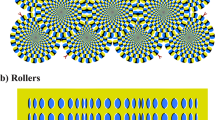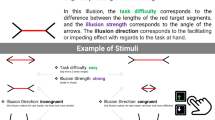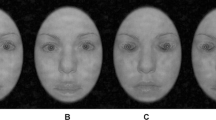Abstract
Five experiments assessed the decline or decrement in illusion magnitude for the wings-out form and the combined or Brentano form of the Müller–Lyer illusion, and for the Poggendorff illusion. Judgments were obtained under conditions of either continuous or intermittent inspection of the illusion figure. In the continuous-inspection conditions observers scanned the illusion figure during the inter-trial intervals whereas in the intermittent-inspection conditions they did not. Substantial illusion decrement was found in all continuous-inspection conditions and in intermittent conditions with short inter-trial intervals (upto 20 s) but not with longer inter-trial intervals. However, intermittent-inspection with a long inter-trial interval (40 s) produced illusion decrement but only when observers were instructed during the decrement session to ignore the wings, and pay attention to the shaft, of the Müller–Lyer figure. Taken together, the pattern of results does not support the claim that illusion decrement is primarily a product of practice or repeated trials.





Similar content being viewed by others
Notes
The results of a supplementary condition, which was performed after the three conditions were completed, restricts the effective temporal limit to less than 20 s. There were 14 subjects none of whom had participated in Experiments 1, 2 and 3 or in the other three conditions of Experiment 4. Each stimulus presentation lasted 10 s, and the inter-trial interval was 20 s. The total duration of the test session was 270 s. Subjects thus made 10 judgments, one for every successive 30 s period. Neither the one-way ANOVA (F(9, 117) =0.95, p >0.05) nor any of the components in the trend analyses was significant indicating that illusion magnitude was constant across the 10 trials.
The major methodological difference between their experiments and the present investigation seem to be the procedure for presenting and measuring illusion magnitude (computer versus paper and pencil methods). These differences are unlikely to account for the inconsistent outcomes, however. Fifteen students, none of whom had participated in the experiments described earlier, were tested under conditions of intermittent-inspection similar to those of Experiment 3 excepting for the procedure, which duplicated Schiano and Jordan’s as closely as possible. Consistent with the results of Experiment 3, there was no evidence, either in the results of the ANOVA or the trend analyses, of a time-related change in illusion magnitude.
References
Beckett, P.A. (1989). Illusion decrement and transfer of illusion decrement in real-and subjective-contour Poggendorff figures. Perception & psychophysics, 45, 550–556.
Burnham, C.A. (1968). Decrement of the Müller–Lyer illusion with saccadic and tracking eye movements. Perception & psychophysics, 3, 424–426.
Chiang, C. (1968). A new theory to explain geometrical illusions produced by crossing lines. Perception & psychophysics, 3, 174–176.
Coren, S., Girgus, J.S. (1972). Differentiation and decrement in the Mueller-Lyer illusion. Perception & psychophysics, 12, 466–470.
Coren, S., & Girgus, J.S. (1978). Seeing is deceiving: The psychology of visual illusions (Hillsdale, NJ: Lawrence Erlbaum Associates).
Day, R.H. (1962). The effects of repeated trials and prolonged fixation on error in the Müller–Lyer figure. Psychological monographs, 76 (Whole No. 533).
Devane, J.R. (1990). Exemplar effect in Mueller-Lyer decrement. Perceptual and motor skills, 70, 15–18.
Di Nuovo, S. (1984). Influence of instructions and cognitive articulation on reducing the Müller–Lyer illusion with a repeated trial. Perceptual and motor skills, 59, 791–796.
Festinger, L., White, C.W., & Allyn, M.R. (1968). Eye movements and decrement in the Muller-Lyer illusion. Perception & psychophysics, 3, 376–382.
Gardner, R.W., & Long, R.I. (1961). Selective attention and the Muller-Lyer illusion. Psychological record, 11, 317–320.
Ginsburg, A.P. (1984). Visual form perception based on biological filtering. In: Spillman L., & Wooten B.R. (Eds.), Sensory experience, adaptation and perception. (pp. 53–72). Hillsdale, NJ: Lawrence Erlbaum Associates.
Girgus, J.S., Coren, S., Durant, M., & Porac, C. (1975). The assessment of components involved in illusion formation using a long-term decrement procedure. Perception & psychophysics, 18, 144–148.
Glaser, A.L., & Slotnick, B. M. (1995). Visual inspection alone produces a decrement in the horizontal-vertical illusion. Perceptual and motor skills, 81, 323–330.
Goyro, K., Robinson, J.O., & Wilson, J.A. (1984). Selective looking in the Muller-Lyer illusion: The effect of changes in the focus of attention in the Muller-Lyer illusion. Perception, 13, 647–654.
Judd, C.H. (1902). Practice and its effects on the perception of illusions. Psychological review, 9, 27–39.
Köhler, W., & Fishback, J. (1950). The destruction of the Müller–Lyer illusion in repeated trials: 1. An examination of two theories. Journal of experimental psychology, 40, 267–281.
Lewis, E.O. (1908). The effect of practice on the perception of the Müller–Lyer illusion. British journal of psychology, 2, 294–306.
MacKay, D.C., & Newbigging, P.L. (1977). The Poggendorff and its variants do arouse the same processes. Perception & psychophysics, 21, 26–32.
Mountjoy, P.T. (1960). Fixation and decrement to the Müller–Lyer figure. Psychological record, 10, 219–223.
Mountjoy, P.T. (1961). Intrasession decrement and intersession recovery to the Mueller-Lyer figure. Perceptual and motor skills, 13, 51–57.
Porac, C. (1994). Decrement and the illusions of the Mueller-Lyer figure. Perceptual and motor skills, 79, 707–717.
Posner, M.I. (1978). Chronometric explorations of the mind. Hillsdale, NJ: Erlbaum.
Predebon, J. (1990). Illusion decrement and transfer of illusion decrement in obtuse-and acute-angle variants of the Poggendorff illusion. Perception & psychophysics, 48, 467–476.
Predebon, J. (1998). Decrement of the Brentano Müller–Lyer illusion as a function of inspection time. Perception, 27, 183–192.
Predebon, J. (2004). Selective attention and asymmetry in the Müller–Lyer illusion. Psychonomic bulletin & review, 11, 916–920.
Predebon, J., Stevens, K., Petocz, A. (1993). Illusion decrement and transfer of illusion decrement in Müller–Lyer figures. Perception, 22, 391–401.
Sarris, V. (1984). On perceptual learning in geometrical-optical illusions. Studia psychologica, 26, 29–37.
Schiano, D.J., & Jordan, K. (1990). Mueller-Lyer decrement: Practice or prolonged inspection? Perception, 19, 307–316.
Selkin, J., & Wertheimer, M. (1957). Disappearance of the Müller–Lyer illusion under prolonged inspection. Perceptual and motor skills, 7, 265–266.
Watson, M., Greist-Bousquet, & S., Schiffman, H.R. (1991). Illusion decrement in wings-in and wings-out Muller-Lyer figures. Bulletin of the psychonomic society, 29, 139–142
Author information
Authors and Affiliations
Corresponding author
Rights and permissions
About this article
Cite this article
Predebon, J. Decrement of the Müller-Lyer and Poggendorff illusions: the effects of inspection and practice. Psychological Research 70, 384–394 (2006). https://doi.org/10.1007/s00426-005-0229-6
Received:
Accepted:
Published:
Issue Date:
DOI: https://doi.org/10.1007/s00426-005-0229-6




